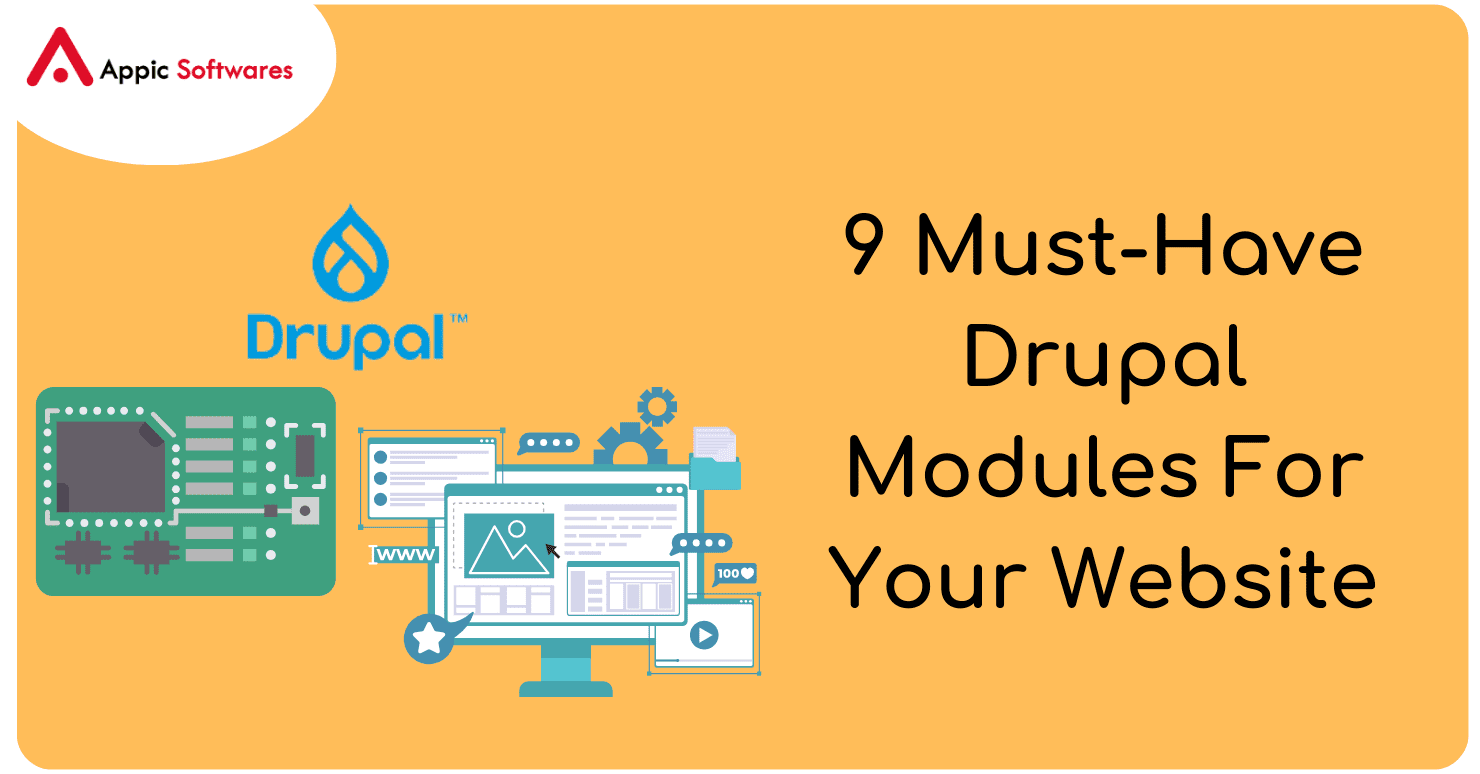
We comprehend. You want Drupal 9 to include every single one of the fantastic features you’ve heard about. When discussing features, you are discussing modules. Choosing your modules is one of the first important decisions you’ll need to make after installing Drupal 9.
Of course, nothing is ever as easy as it seems. The open-source community that supports Drupal 9 is constantly expanding and works hard to create thousands of modules that can improve and extend the functionality of a Drupal website. Deciding on a Googleplex of Drupal 9 modules can be difficult. There must be a more effective approach than simply assuming which modules would meet your needs. Well, not really, no. However, we do have a useful list of suggested modules and best practices for selecting modules that were compiled by our Specbee developers.
Let’s get started with a list of the top Drupal 9 modules you need to have to create fantastic digital experiences. Following that, we’ll discuss how to choose your Drupal modules.
9 Must-Have Drupal Modules
Admin Tool Bar Module
The Drupal Admin Toolbar module is a lifesaver for site administrators and site builders. The default Toolbar is still functional, but it’s less streamlined for users. This module enhances the toolbar’s functionality by providing drop-down menus for quick access to various admin pages. Additionally, it includes Admin Toolbar Extra Tools as a submodule to increase its usefulness. To the admin menu, this submodule adds even more useful links for carrying out operations like flushing the cache and running cron.
Paragraphs Modules
Put the control in the hands of content authors and editors by enabling them to quickly create flexible and structured material with the Drupal 9 Paragraphs Module if you want to avoid any complaints from your content providers. They may now add a variety of field kinds for the paragraphs with ease, including photographs, text blocks, quotes, slideshows, videos, and much more.
They can add or fiddle with paragraph items and move them around using the well-known node edit form. Additionally, it offers widgets with drag-and-drop capabilities, the ability to duplicate paragraphs, and many other features that can improve the user experience when using the Paragraphs module.
Webform Module
One of the most important and functional Drupal 9 modules is this one. So much so that it is constantly on our list of suggested modules. A contact form, a survey form, or any other type of visitor interaction is needed for almost every website. A powerful form builder that is simple to customize and extend is the Drupal 9 Webform Module. You can use it to gather data from forms, transfer it to outside programs, or email administrators or users. This data can also be exported to spreadsheets for additional examination. We’re only beginning to scrape the surface. The Webform module offers so much more that it probably merits its post.
Layout Builder
Layout builder allows content editors and site builders to quickly create pages by selecting from a library of predefined layouts. Be aware that to utilize this core module in Drupal 9, you must first enable it. It offers a drag-and-drop user interface with a WYSIWYG layout, making it incredibly user-friendly and adaptable, even for inexperienced users. It is a distinctive and effective page creation tool thanks to its real-time preview capability. When you connect Layout Builder with these modules, you can even quickly expand its functionality.
Devel Module
Developers and site administrators will find the Drupal Devel module to be a highly useful tool. Because of its capacity to produce a lot of content for nodes, comments, users, and different content types and entities, it is frequently used for testing purposes. Additionally, it enables programmers to troubleshoot any node access issues. With the use of its submodule, Webprofiler, page footers can be added for all pages. The site administrators can access basic analytics from Webprofiler about resource usage, database queries, and caching capabilities.
Twig Tweak Module
The Twig tweak module will become your best buddy if you’re a developer working with intricate twig templates. This module offers a variety of filters and functions that will not only make creation easier but also better. Additionally, it aids engineers in producing well-organized, understandable code.
Drupal GraphQL Module
A contemporary querying language called GraphQL has replaced dated ones (like REST) for interacting with APIs. As opposed to all the extra baggage that comes with a REST API call, it is faster and only displays the results you are looking for. The Drupal GraphQL module allows you to expose Drupal entities to GraphQL client applications and generate GraphQL schemas for your Drupal website.
Redirect and Pathauto Module
Broken connections are disliked by everyone, especially our acquaintances at Google (who may not be our acquaintances). The Drupal 9 Redirect module can assist you in preventing upsetting the internet if you’ve modified your URL structure or decided not to offer that content any longer. Making URL redirection is simple thanks to this incredibly useful module.
Beyond appropriate redirects, having well-structured URLs is essential for search engine optimization and enhances user experience. In every Drupal project, the Pathauto module is unquestionably a requirement. It aids in the automatic creation of SEO-friendly and properly structured URLs. By altering the tokens the pattern system utilizes, site administrators can also change it.
Google Analytics
The Drupal Google Analytics module offers a Google Analytics tracking system to your website, which is arguably the most obvious benefit. All Google Analytics features may be accessed and linked with your website using this Drupal plugin. It enables a variety of functions, including site search, Adsense support, domain tracking, user tracking, monitoring tracked links, monitoring downloaded files, and more.
Things To Consider Before Choosing Drupal Modules
The availability of options is both an advantage and a disadvantage of any open-source system. You can always find more than one module for any capability, whether it be personalization modules, social media integration modules, marketing automation modules, or any other module. Before selecting which to employ, bear the following in mind:
Compatibility
You should ascertain a module’s compatibility with your Drupal version before downloading it. On the project page for the module on Drupal.org, scroll to the bottom to locate the download link and the release versions listed, where you can check what version of the module has been issued. Go to http://drupal.org/project/Modules/name and filter by Core compatibility if it isn’t stated.
Despite being free, they take up space.
One thing to bear in mind is that while the Drupal modules that have been contributed are free, they are not bulk-free. Unused modules can take up a lot of storage space and system resources without being used, which makes your Drupal website heavier and slower. Therefore, consider whether you need a module before downloading it and whether any other core modules you already use can provide the same functionality for your website. Don’t be afraid to remove those inactive and rarely used modules to make your website lighter and healthier.
Modules That Are Actively Maintained
Selecting modules that are actively updated, maintained, and released by the creators is crucial. mainly because the developer or contributor will probably respond more quickly if you encounter any security flaws or other problems. Additionally, your chances of receiving an updated version shortly will be significantly higher.
Popularity
Although it may seem apparent, adopting well-known modules usually means you can rely on them to complete their tasks securely and without too many problems. You may view the number of downloads and the number of websites utilizing a specific module on the project page for that module on Drupal.org.
Watch out for problems
The number of issues and bugs (both open and closed) related to a particular Drupal module can be found on the right side of the project page for that module. You may see a complete summary of all faults and issues by clicking the link, which will help you determine whether the module will offer the functionality you need. You can get a sense of the developers’ responsiveness by looking at the ‘Last Updated’ date.
The Best Drupal Development Company
Appic Softwares is a leading Drupal development company that can help you create or maintain Drupal software. We have an experienced team of Drupal developers who have worked on various projects across several industries and have managed various clients.
You can even hire dedicated Drupal developers from us for your project. So, what are you waiting for?
This blog is inspired by <https://www.specbee.com/blogs/top-drupal-9-modules-for-your-drupal-project>








